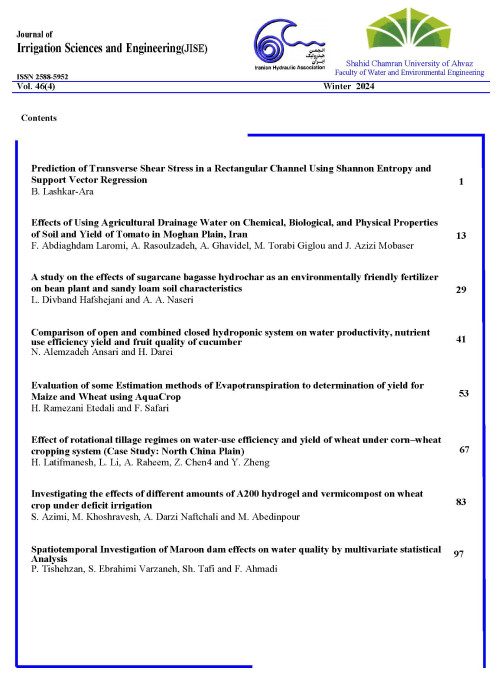Effect of Intake Particle Dimension and Grain Size on Discharge Coefficient in Porous Bottom Intakes Using Physical Modeling
Author(s):
Article Type:
Research/Original Article (دارای رتبه معتبر)
Abstract:
Water intake from the river is done using several methods. Each method has its own features and limitations. In steep mountain rivers with irregular bed, high values of sediment transport and flash floods may prevent the application of gated dams; therefore, the bottom intakes are often used. In this method, in some part of the river width and length, a trench is created with a proper cross section and water is flowed through this trench into the diversion channel. In order to prevent the coarse particles to enter, top of the trench is covered with bottom rack bars. Corrosion of the bars, clogging, and maintenance are the common problems of bottom racks, which make them unusable in long term. To solve these problems, a new system of bottom intake with porous media is introduced. In this method, after trenching in the river bed, materials with appropriate aggregation are ýdumped in the trench and water intakes from the river through a diversion channel. ý This means that a portion of flow into the porous media; then move to the diversion channel. Another portion of the water passes over the bottom intake and finally drive to the river. Usage of the porous media has, however, many limitations; but it has some advantages, such as, no suspended solids in the water, respect for the environmental problems, no change in natural morphology of the river, withstanding in different weather conditions, and dealing with the problem of freezing, and corrosion, easy to construct and applicability, affordability and availability of materials. Despite a long history of research in thre field of bottom rack intakes, few studies about these structures with porous media have been previously done. In previous experiments, in order to separate the diverted flow from the non-passed flow, a bottom intake with porous media with a diversion channel parallel to the main channel was used, so that the diverted flow was unidirectional to the main channel. But, in practice, diversion channel in the bottom intakes is usually performed perpendicular to the main channel. Therefore, it affects the hydraulic parameters and diverted discharge. Besides, in previous experiments, by considering the constant height and length, the effect of these two factors has not been investigated for the intake. Therefore, in the present study, in order to precisely investigate the hydraulic behavior of the bottom rack intakes, in addition to the implementation of a channel perpendicular to the main channel as a diversion channel, various factors such as the length and height of the intake, the effects of uniformity of particles and different slopes of intake have been experimentally investigated. The results of experiments on laboratory models in this study may reveal some of the unknown points in application of this method and it provides the possibility of design and operation of this structure in the natural environment.
Keywords:
Language:
Persian
Published:
Irrigation Sciences and Engineering, Volume:41 Issue: 2, 2018
Pages:
107 to 117
magiran.com/p1846533
دانلود و مطالعه متن این مقاله با یکی از روشهای زیر امکان پذیر است:
اشتراک شخصی
با عضویت و پرداخت آنلاین حق اشتراک یکساله به مبلغ 1,390,000ريال میتوانید 70 عنوان مطلب دانلود کنید!
اشتراک سازمانی
به کتابخانه دانشگاه یا محل کار خود پیشنهاد کنید تا اشتراک سازمانی این پایگاه را برای دسترسی نامحدود همه کاربران به متن مطالب تهیه نمایند!
توجه!
- حق عضویت دریافتی صرف حمایت از نشریات عضو و نگهداری، تکمیل و توسعه مگیران میشود.
- پرداخت حق اشتراک و دانلود مقالات اجازه بازنشر آن در سایر رسانههای چاپی و دیجیتال را به کاربر نمیدهد.
In order to view content subscription is required
Personal subscription
Subscribe magiran.com for 70 € euros via PayPal and download 70 articles during a year.
Organization subscription
Please contact us to subscribe your university or library for unlimited access!


